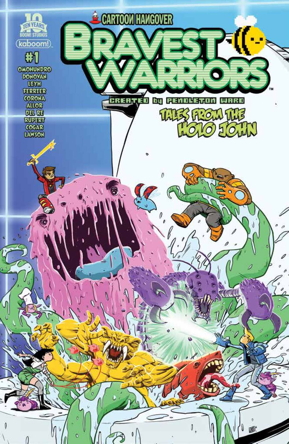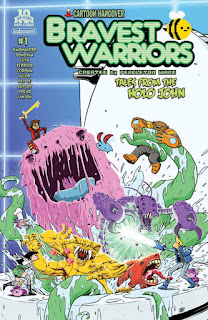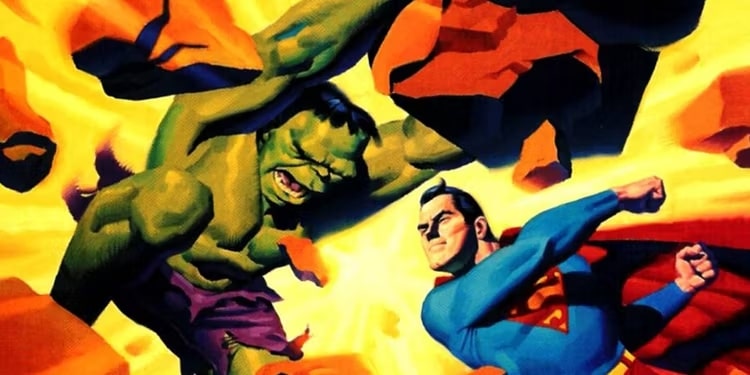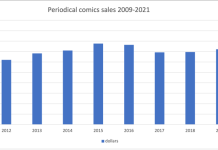By John Jackson Miller
[Reprinted with permission from Comichron.com.]

That’s enough to place the issue fourth on the list of best-selling comics of the century, and it could go higher with reorders. It came in a month when strong six-figure launches from A-Force and Old Man Logan, and a dominating performance from Batman: Earth 2 Vol. 2 on the graphic novel charts helped push the market to a 13% increase.
The Secret Wars issue edged out a surprise second-place finisher, Bravest Warriors: Tales from the Holo John #1 — and with the comic book, Loot Crate‘s effect on the Direct Market sales charts may finally have reached — pun entirely intended — cartoonish levels. Just over half a million copies of the comic book based on the animated series were shipped by Diamond, and indications are that most of those copies went directly to one customer: Loot Crate, which then doled them out to its subscribers (who do not know in advance what comic books they’re going to receive). When the regular Bravest Warriors title appeared on the periodical charts more than a year ago, it was selling around the 4,000 copy level, and while this first issue likely sold more copies than that in comic shops, it’s likely that more than 98% of the copies went to one customer.
The massive single order had effects on the charts in several ways. Comics unit sales were up 20% over last May: 7.5% of that came from the Loot Crate copies. Industry sales went up $5.8 million versus last May, but $2.5 million of that came fromBravest Warriors. The title cost $4.99, so it helped punch up the weighted average cover price — the price of the average comic book Diamond shipped — to a record $4.17; without the inclusion of the Loot Crate books, that average drops to $4.11. (Still a record, but it only beats the last one — set in April — by nine cents.) It also sent Boom‘s market share northward, making it the #4 publisher in terms of units sold last month — and #3 in dollar sales within just the Top 300.
Where we don’t see the distortion is in Diamond’s dollar shares, which only look at the dollars it was paid — and there, Boom is in fifth place. According to Diamond’s dollar rankings, it sold 2.4 copies of Bravest Warriors for every Secret Wars #2 it sold — and yet the distributor made more money on Secret Wars #2. Since Secret Wars #2 and Bravest Warriors cost the same — $4.99 — that would indicate that Loot Crate got a much better deal from Boom at wholesale on its copies than retailers got from Marvel. In the case of this issue and Februrary’s chart-topping Orphan Black, it’s probably more appropriate to look at these as promotional copies. Diamond stopped including comics promotionally cover-priced below $1 in its charts several years ago, but there doesn’t appear to be a rule concerning a wholesale price minimum. (If there were, we wouldn’t see graphic novels sold at deep discounts included in the charts — and those have often distorted the sales figures by several million dollars.)
There is, again, no single rule I can think of that would easily fit all occasions here — and as the number of box offerings proliferates, the potential impact on the charts grows. (Secret Wars #1 itself was in the Comic Block, Geek Fuel, and Comic Con boxes in May, and Convergence: Action Comics #1 andMythic #1 were also in the Comic Block box, although the numbers involved are likely much smaller than the Loot Crate case. It’s also not clear whether they’re all going through Diamond: DC didn’t go through Diamond with its first Loot Crate offering.) About the only suggestion I might have would be for Diamond to remove from the Top 300 charts sales any non-Direct Market accounts that do not order a variety of comics monthly; that would allow in sales from outlets like Hastings, but separate out promotional one-off purchases by outside firms. Such titles might be reported as an addendum to the charts, such that we’d know how they affected the market shares and bottom line; publishers would also see their sales reflected in that event. But that approach might be more difficult to do as the number of grab-bag retailers increases.
The aggregate changes are as follows:
TOP 300 COMICS UNIT SALES
May 2015: 8 million copies
Versus 1 year ago this month: +20%
Versus 5 years ago this month: +30%
Versus 10 years ago this month: +36%
Versus 15 years ago this month: +33%
YEAR TO DATE: 37.16 million copies, +16% vs. 2014, +29% vs. 2010, +26% vs. 2005, +30% vs. 2000
ALL COMICS UNIT SALES
May 2015 versus one year ago this month: +19.53%
YEAR TO DATE: +16.9%
May 2015: $33.34 million
Versus 1 year ago this month: +33%
Versus 5 years ago this month: +55%
Versus 10 years ago this month: +96%
Versus 15 years ago this month: +105%
YEAR TO DATE: $146.69 million, +21% vs. 2014, +46% vs. 2010, +75% vs. 2005, +94% vs. 2000
ALL COMICS DOLLAR SALES
May 2015 versus one year ago this month: +19.94%
YEAR TO DATE: +16.48%
May 2015: $7.27 million
Versus 1 year ago this month: unchanged
Versus 5 years ago this month: +21%
Versus 10 years ago this month, just the Top 100 vs. the Top 100: +28%
Versus 15 years ago this month, just the Top 25 vs. the Top 25: +34%
YEAR TO DATE: $35.1 million, -1% vs. 2014
ALL TRADE PAPERBACK SALES
May 2015 versus one year ago this month: -0.29%
YEAR TO DATE: +3.41%
May 2015: $40.61 million
Versus 1 year ago this month: +26%
Versus 5 years ago this month: +38%
Versus 10 years ago this month, counting just the Top 100 TPBs: +72%
Versus 15 years ago this month, counting just the Top 25 TPBs: +118%
YEAR TO DATE: $181.76 million, +16% vs. 2014
ALL COMICS AND TRADE PAPERBACK SALES
May 2015 versus one year ago this month: +13.49%
YEAR TO DATE: +12.31%
May 2015: approximately $48.89 million (subject to revision)
Versus 1 year ago this month: +13%
Versus 5 years ago this month: +39%
Versus 10 years ago this month: +83%
YEAR TO DATE: $233.5 million, +12% vs. 2014
RELEASES
New comic books released: 436
New graphic novels released: 228
New magazines released: 44
All new releases: 708
As mentioned above, the average cover price of the comic books in Diamond’s Top 300 was $3.95, a record; there were 205 comics priced at $3.99, 26 above that mark, and 69 below. There were only 38 comics in the chart prices at $2.99, the previous most common price point. Click to see cover prices across time.
Our joint report with ICV2 on 2014’s overall comics sales is being finalized; look for it here in the coming days.










Hmm… Do the Loot Crate sales help the single issue sales for the next issue?
Or is most of that demand fulfilled by digital comics?
Loot Crate advertises a $40+ box for $13.95. That’s, at least, a 65% discount. (70% if you get the annual plan.)
It’s been difficult to see any impact in sales because the sample is too small, and most Loot Crate comics have been first issues. So far I think only the Walking Dead and Batman issues were mid-series. There’s no way to really tell from #2s whether they were helped — the drop off from first issues in general is all over the map.
Whatever Loot Crate gets for what it sends out, it appears from the dollar rankings that they’re buying the comics at much better than the usual Diamond retail discount. I would suspect in some cases Diamond is just getting a handling fee, with the publishers offering the comics at cost or less. It’s a promotional tool more than it is a retail sale.
Do we know what the sales were on the first issue of the original Secret Wars?
Also, I remember George Perez saying in an interview (I think in Focus on George Perez) what the sales for the first issue of Crisis were. Anybody know?
Both predate the first indexed sales charts from Capital, and there was no postal reporting in miniseries. I would doubt based on other titles at the time that Secret Wars hit half a million, but I would need to go back and look at some other data. I did have an estimate on Crisis at one point but I again need to check.
My first memory was Perez said 535,000. But 435,000 and 375,000 have bounced through my head also. Wish I could find my copy of FOGP. Heidi, still have yours?
I can believe the 500k number for Crisis. Capital City Distribution’s orders on almost every issue of the series were in the 40,000s, and in 1985, Capital represented about 8% of DC’s sales on titles that also went to the newsstand. That amounts to nearly 500k. Secret Wars, a year earlier, could get there but it’d have to be outselling X-Men by a ways to do it — and it was priced 25% higher.
What I am guessing is that a large % of people getting Loot Crate may not buy comics, so getting comics into non-readers hands is always a good thing, like free comic book day. The chance that a non comic reader might like the book and track down more at a comic shop is always there, and always a good thing for the industry. It is win-win for everyone.
If Loot Crate is helping usher folks to shops, it’s going to be so hard to tell from just the numbers, ya know? Shop owners have already had their orders in for the subsequent issue(s) by the time we even hear if Loot Crate ordered something. (But maybe I’m wrong on that. Dunno how shop owners would know, unless they were close with their Diamond rep?) Maybe reorders or second printings would be a better indicator of a Loot Crate effect?
Of course, as John Jackson Miller pointed out, the sample space really isn’t there to gather any firm insights for how effectively this can broaden readership. But I’m with Palmiotti; any gains are more than welcome. The fact that Loot Crate continues to order comics shows that their customers are interested in them (or at least not adverse to them.) If anything, an increase in including comics in crates might indicate positive feedback, so here’s to hoping.
Comments are closed.